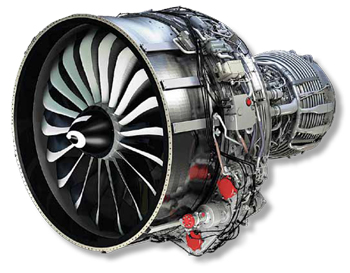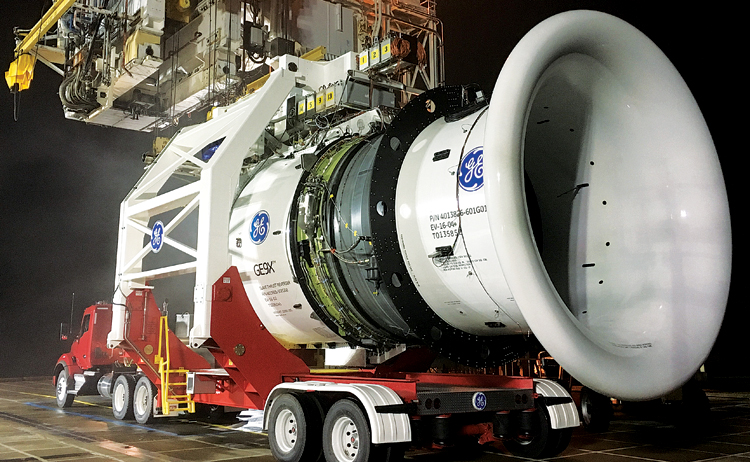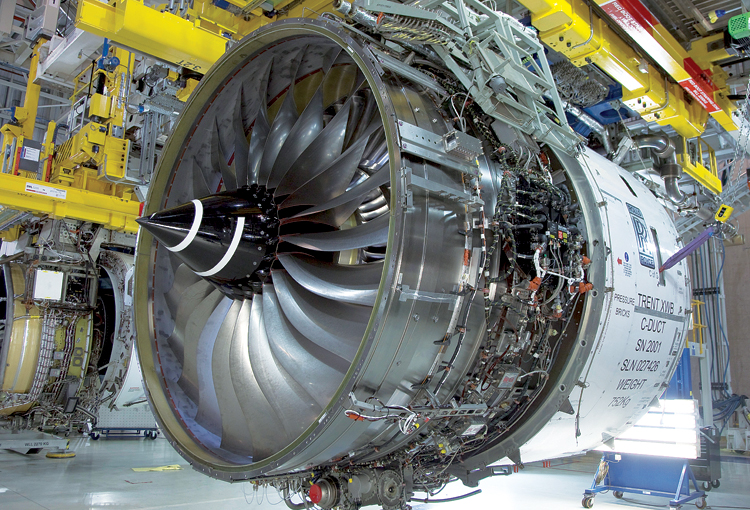Large Commercial Engines – Big is Beautiful
The airline industry strives to reduce emissions through a combination of technology, operational improvements and the use of sustainable aviation fuel (SAF)

The 26th Conference of the Parties to the UN Framework Convention on Climate Change (COP26) took place in Glasgow in November 2021. It had a strong emphasis on decarbonising transport. In 2019, aviation accounted for just 2.8 per cent of global CO2 emissions, according to the International Energy Agency (IEA). However, as global economies recover from the COVID-19 shock, and with the number of air travellers expected to surge over the next 30 years, this figure is predicted to grow at rates above the global average for all emissions. The International Air Transport Association (IATA) has committed its members to net-zero carbon emissions by 2050.

The airline industry strives to reduce emissions through a combination of technology, operational improvements and the use of sustainable aviation fuel (SAF). Technology helps in two ways. First, by developing more efficient planes and spurring the replacement of older fuel-guzzling ones. Second, by enabling airlines to operate with high levels of SAF blended with conventional jet fuel. The most important factor in building better performing and less emissive jet airliners is improving their turbofan engines. Thanks to constant R&D efforts by companies such as General Electric Aviation, CFM International, Pratt & Whitney and Rolls-Royce, jet engines are becoming more powerful and more fuel-efficient and are generally larger than their predecessors.
GENERAL ELECTRIC’S GREATS
GE Aviation entered the commercial aviation business in 1971 with the CF6 turbofan. This high bypass engine provided a historic breakthrough in fuel efficiency. Fifty years later, with sales of over 8,500 engines, the CF6 is GE’s most successful wide-body engine programme. It is fitted on the Airbus A300, A310 and A330, the Boeing 747 and 767 as also on some other airliners. The General Electric GE90 entered service in 1995 on the Boeing 777. It incorporated lightweight and innovative carbon fibre blades, using composites for the first time in commercial engines. The GE90 Growth versions, GE90-110B and -115B, are the exclusive power plants for several; Boeing 777 variants. The General Electric GEnx, fitted on the Boeing 787 and 747-8, is the fastest-selling, high-thrust jet engine in GE Aviation’s history.

Looking to the future, the General Electric GE9X turbofan, designed for the Boeing 777X, produces 1,05,000 pounds of thrust (lbf) for a total of 2,10,000 lbf for the twinjet. In 2019, the GE9X set a new Guinness World Record and became the most powerful commercial aircraft engine in history, reaching 1,34,300 lbf under testing. Yet it is the quietest GE engine ever produced in terms of pounds of thrust per decibel. The GE9X engine’s front fan diameter is 134 inches. With its casing, it is wider than the fuselage of a Boeing 737. The Boeing 777X/GE9X combination is planned to begin commercial service in 2024 and targeted to deliver a 20 per cent fuel burn improvement over its predecessors.
INCREDIBLE CFM INTERNATIONAL
In 1974, a 50/50 partnership between Safran Aircraft Engines and GE Aviation called CFM International (CFMI), was set up. The fruit was the world’s best-selling CFM56 engine and the advanced technology LEAP engine, which seems set for an equally impressive record. Strangely enough, the CFM56 did not attract a single order for the first five years and was on the verge of being scrapped before substantive orders were received. Today, with more than 33,000 units delivered, CFM56 engines mainly power narrow-body commercial jets including the Airbus A320 family, the Airbus A340-200/-300 and the Boeing 737 Classic and Next Gen variants. The CFM56 develops 18,500 to 33,000 lbf. It offers dispatch reliability approaching 100 per cent, along with unrivalled time “on-wing” (without removal for servicing) – both of which significantly reduce operating costs.
The CFM56 has been succeeded by the CFMI LEAP (“Leading Edge Aviation Propulsion”) high-bypass turbofan. The LEAP entered service in August 2016 and comes in three variants – the LEAP-1A fitted on the Airbus A320neo family, the LEAP-1B that powers the Boeing 737 MAX and the LEAP-1C fitted on the Comac C919. 2018 was a year of transition for CFMI when deliveries of LEAP engines overtook those of the CFM56 for the first time. As of today, the LEAP and has logged over 12 million engine flight hours in commercial operation. It delivers a 15 per cent improvement in fuel consumption, compared to the best CFM56 engines and maintains the same level of dispatch reliability and life-cycle maintenance costs. Overall, CFMI has produced the world’s largest fleet of jet engines in the narrowbody market.
PURE PRATT & WHITNEY
Pratt & Whitney has more than 13,000 large commercial engines installed today. The PW4000 entered service in 1984, with the PW4000-94 offered on the Boeing 747-400 and 767-200/300 as well as the Airbus A300 and A310. The PW4000-112, the largest and most powerful of the PW4000 family, is an ultra-high-thrust model. It was designed for the Boeing 777 and is one of the three options for all 777 models except the 777-200LR and 777-300ER. It has a fan diameter of 112 inches and a thrust of 74,000 to 90,000 pounds.
The forthcoming Rolls-Royce UltraFan engine is expected to take Rolls-Royce ahead of General Electric for the top spot in engine size
For the past few years, Pratt’s fate has been intimately linked with the geared turbofan (GTF) engine series. The GTF that entered service in 2016 has a new and superior architecture with immense potential for growth. It has been renamed PW1000G, the first in a new line of Pratt’s “PurePower” engines. They are now proving their worth by delivering the predicted fuel savings on the Airbus A220 and Embraer’s second generation E-Jets, the Irkut MC-21 and Airbus A320neo, among other aircraft. Pratt & Whitney claims the PW1000G is 16 per cent more fuel-efficient than engines used on narrow-body airliners, as well as up to 75 per cent quieter.
Pratt is also a member of two very successful engine partnerships. The V2500 turbofan is one of three options for the Airbus A320 family and powers the McDonnell Douglas MD-90 and the Embraer KC-390. It is designed and manufactured by International Aero Engines, a global partnership that includes Pratt & Whitney, Japanese Aero Engine Corporation and MTU Aero Engines. The GP7000 turbofan is manufactured by Engine Alliance, a joint venture between General Electric and Pratt & Whitney. It is one of the options for the Airbus A380.
REMARKABLE ROLLS-ROYCE
Rolls-Royce is the world’s second-largest engine manufacturer after General Electric. Its major programmes are the Trent 1000, 7000 and XWB. Members of the Trent family have been in service since the 1990 on the Airbus A330, A340, A350 and A380, as well as the Boeing 777 and 787 Dreamliner.

The Trent XWB is Rolls-Royce’s most powerful and lowest carbon emission turbofan and is over 15 per cent more fuel efficient than the first Trent engine. It is the largest engine from Rolls-Royce and the third-largest overall. It is the exclusive engine for the Airbus A350. There are two versions for the A350-900 and the A350-1000 (the XWB-84 and XWB-97), with a thrust of up to 84,200 and 97,000 pounds, respectively. The fan for the Trent XWB has a 118 inch diameter. Combined, over 1,000 engines of the Trent XWB have been delivered and they have accumulated more than eight million engine flying hours. The Trent XWB powers the world’s longest scheduled flight – 15,345 km from Changi, Singapore to Newark, USA.
Many airlines operating on international routes are retiring their fuelgulping quad aircraft and replacing them with far more economical and less emissive twinjets
The forthcoming Rolls-Royce UltraFan engine is expected to take Rolls-Royce ahead of General Electric for the top spot in engine size. The huge fan with a diameter of 140 inches is manufactured using composite materials which reduces the weight of the engine by up to 1,500 pounds. The UltraFan will run on SAF and is expected to be 25 per cent more fuel-efficient than the original Trent engines. Entry into service is expected before 2030.
TWINJETS TRIUMPHANT
A decisive shift is discernible in wide-body configuration. Earlier, four-engine (or “quad”) aircraft were essential for transoceanic flights, as Extended Range Operation with Two-Engine Airplanes (ETOPS) were insufficient. But today’s twinjet wide-bodies have ample ETOPS range. For instance, the Airbus A350-1000 with its Rolls-Royce Trent XWB-97 engines has a huge 420-minute ETOPS and the Boeing/GE Aviation twinjet offerings are not far behind. That is why, many airlines operating on international routes are retiring their fuelgulping quad aircraft and replacing them with far more economical and less emissive twinjets.
Meanwhile, companies such as Airbus have ambitious plans to develop clean hydrogen planes within 15 years. However, till such aircraft enter commercial service there is no alternative to reducing the emissions from commercial jet flights. And large, fuel-efficient turbofan engines are perhaps the best means to achieve this goal.





